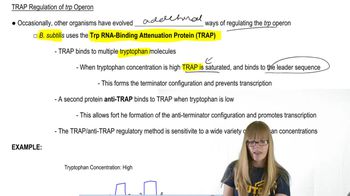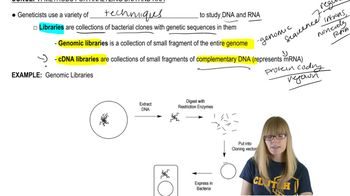Table of contents
- 1. Introduction to Genetics51m
- 2. Mendel's Laws of Inheritance3h 37m
- 3. Extensions to Mendelian Inheritance2h 41m
- 4. Genetic Mapping and Linkage2h 28m
- 5. Genetics of Bacteria and Viruses1h 21m
- 6. Chromosomal Variation1h 48m
- 7. DNA and Chromosome Structure56m
- 8. DNA Replication1h 10m
- 9. Mitosis and Meiosis1h 34m
- 10. Transcription1h 0m
- 11. Translation58m
- 12. Gene Regulation in Prokaryotes1h 19m
- 13. Gene Regulation in Eukaryotes44m
- 14. Genetic Control of Development44m
- 15. Genomes and Genomics1h 50m
- 16. Transposable Elements47m
- 17. Mutation, Repair, and Recombination1h 6m
- 18. Molecular Genetic Tools19m
- 19. Cancer Genetics29m
- 20. Quantitative Genetics1h 26m
- 21. Population Genetics50m
- 22. Evolutionary Genetics29m
18. Molecular Genetic Tools
Methods for Analyzing DNA
Problem 27e
Textbook Question
You have identified an enhancer trap line (see Figure 14.17) generated by P element transposition in Drosophila in which the marker gene from the enhancer trap is specifically expressed in the wing imaginal disc.
How would you show that the expression pattern of the enhancer trap line reflects the endogenous gene expression pattern of the adjacent gene?
 Verified step by step guidance
Verified step by step guidance1
<Identify the adjacent gene to the enhancer trap insertion site using molecular techniques such as inverse PCR or genome sequencing.>
<Analyze the expression pattern of the adjacent gene using in situ hybridization or RT-PCR to determine its expression in the wing imaginal disc.>
<Compare the expression pattern of the adjacent gene with the expression pattern of the marker gene from the enhancer trap line in the wing imaginal disc.>
<Perform a genetic complementation test by creating a mutant allele of the adjacent gene and observing if the enhancer trap line rescues the mutant phenotype.>
<Use reporter gene assays to confirm that the regulatory elements driving the expression of the marker gene are the same as those driving the expression of the adjacent gene.>
Recommended similar problem, with video answer:
 Verified Solution
Verified SolutionThis video solution was recommended by our tutors as helpful for the problem above
Video duration:
3mPlay a video:
Was this helpful?
Key Concepts
Here are the essential concepts you must grasp in order to answer the question correctly.
Enhancer Traps
Enhancer traps are genetic tools used to study gene expression patterns. They consist of a reporter gene that is activated by nearby enhancers, allowing researchers to visualize where and when specific genes are expressed. In Drosophila, enhancer traps can help identify regulatory elements that control gene expression in various tissues, such as the wing imaginal disc.
Recommended video:
Guided course

Alternative trp regulation
Gene Expression Patterns
Gene expression patterns refer to the spatial and temporal expression of genes within an organism. These patterns are crucial for understanding developmental processes and tissue differentiation. By comparing the expression of the enhancer trap marker with the expression of the adjacent endogenous gene, researchers can determine if the enhancer trap accurately reflects the natural expression pattern of that gene.
Recommended video:
Guided course

Penetrance and Expressivity
In Situ Hybridization
In situ hybridization is a technique used to detect specific RNA sequences within fixed tissues or cells. This method allows researchers to visualize the localization of gene expression at the cellular level. By applying in situ hybridization to both the enhancer trap and the adjacent gene, one can compare their expression patterns directly, providing evidence that the enhancer trap reflects the endogenous gene's expression.
Recommended video:
Guided course

Drosophila P Element

 7:40m
7:40mWatch next
Master Methods for Analyzing DNA and RNA with a bite sized video explanation from Kylia Goodner
Start learningRelated Videos
Related Practice


